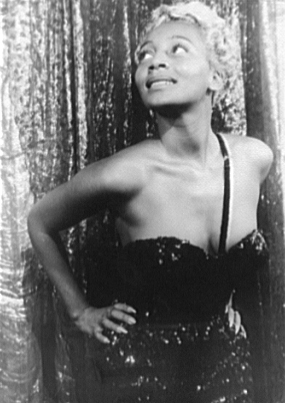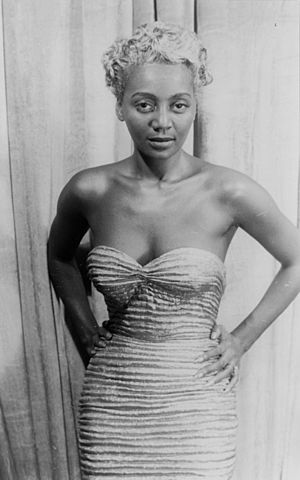Joyce Bryant facts for kids
Quick facts for kids
Joyce Bryant
|
|
|---|---|

Bryant in 1953
|
|
| Background information | |
| Birth name | Ione Emily Bryant |
| Born | October 14, 1927 Oakland, California, U.S. |
| Died | November 20, 2022 (aged 95) |
| Genres |
|
| Occupation(s) | Singer, actress, recording artist, dancer, civil rights activist |
| Instruments | Vocals |
| Years active | 1946–1955; 1960s–2000s |
| Labels |
|
Joyce Bryant (October 14, 1927 – November 20, 2022) was a famous American singer, dancer, and activist. She became very popular in the late 1940s and early 1950s. People knew her for her unique silver hair and tight "mermaid" dresses. She earned nicknames like "The Bronze Blond Bombshell" and "The Voice You'll Always Remember."
Bryant stopped performing in 1955 when she was at the peak of her fame. She chose to dedicate her life to the Seventh-day Adventist Church. Later, she returned to music as a trained classical singer. She also became a vocal coach for other artists.
Contents
Early Life and First Steps in Music
Joyce Bryant was born in Oakland, California, and grew up in San Francisco. She was one of eight children. Her father worked for the Southern Pacific Railroad. Her mother was a very religious Seventh-day Adventist. Joyce was a quiet child and dreamed of becoming a sociology teacher.
In 1946, when she was visiting family in Los Angeles, she sang at a local club. It started as a dare, but soon she was the only one singing. The club owner offered her $25 to perform on stage. She took the money because she needed it to get home. This was her unexpected start in music.
A Star's Rise to Fame
In the late 1940s, Joyce Bryant began getting regular singing jobs. She performed at famous places like La Martinique nightclub in New York City. She also toured many hotels in the Catskill Mountains. Her fame grew steadily.
One night, she was performing on the same stage as Josephine Baker. Joyce wanted to stand out. She colored her hair silver using radiator paint! She also wore a tight silver dress and a long silver mink coat. When she walked on stage, she "stopped everything!" Her silver hair and sparkling dresses became her signature look.
Combined with her amazing four-octave voice, this made her a huge star. By the early 1950s, she was known as "The Bronze Blond Bombshell" and "the black Marilyn Monroe." Other singers, like Etta James, looked up to her style.
Starting in 1952, Joyce Bryant released several songs with Okeh Records. These included "A Shoulder to Weep On" and "After You've Gone."
Fighting for Fairness
Joyce Bryant often faced unfair treatment because of her race. She spoke out against racial inequality. In 1952, she became the first Black entertainer to perform at a hotel in Miami Beach, Florida. She did this even after receiving threats from the Ku Klux Klan.
She also spoke out against unfair rules at clubs and hotels. She wanted entertainers to work together to fight against Jim Crow laws. These laws enforced segregation and discrimination.
In 1954, she was one of the first Black singers to perform at the Casino Royal in Washington, D.C.. She was happy to see many African-Americans attend the club. She noted they were treated kindly by the staff.
In 1953, Life magazine featured Joyce Bryant in a photo spread. The next year, Ebony magazine named her one of the five most beautiful Black women in the world. Other stars like Lena Horne and Dorothy Dandridge were also on the list.
Leaving and Returning to Music
By the mid-1950s, Joyce Bryant was earning a lot of money. But she was tired of the entertainment world. The silver paint had damaged her hair. She also didn't like working on the Sabbath, a day of rest for her church. She felt uncomfortable with her public image. She also had a very sore throat from performing so much.
In late 1955, Joyce Bryant decided to quit performing. She dedicated herself to the Seventh-day Adventist Church. She even went to Oakwood College in Huntsville, Alabama. Ebony magazine wrote an article about her new life. It was titled "The New World of Joyce Bryant: Former Café Singer Gives Up $200,000-a-year Career to Learn to Serve God."
Joyce traveled through the South for years. She became angry when she saw hospitals refusing to help Black people in need. So, she organized events to raise money for food, clothing, and medicine for Black communities. She also held concerts to raise money for her church. For these concerts, she wore her natural black hair and no makeup.
Joyce Bryant often met with Martin Luther King Jr., who was a fan of her singing. She supported his efforts to help Black people get basic necessities. Joyce believed that fighting for civil rights was important for everyone who believed in God. However, her church did not want to take a stand against discrimination. They said these were "earthly matters" and not spiritual.
Feeling disappointed, Joyce Bryant returned to entertainment in the 1960s. She trained to become a classical singer. She performed with the New York City Opera and toured internationally. In the 1980s, she returned to jazz music. She also became a vocal coach, teaching singers like Jennifer Holliday. A documentary about her life, called Joyce Bryant: The Lost Diva, is being made.
Later Life and Passing
Joyce Bryant passed away on November 20, 2022. She was 95 years old.


